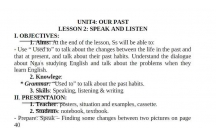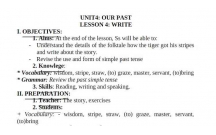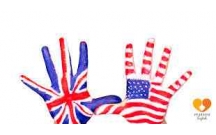
Home
Giáo án bài giảng
Giáo án, bài giảng lớp 8
TIẾNG ANH 8 CHỦ ĐỀ Our past : Quá khứ của chúng ta - Lesson 2
TIẾNG ANH 8 CHỦ ĐỀ Our past : Quá khứ của chúng ta - Lesson 2
UNIT4: OUR PAST
LESSON 2: SPEAK AND LISTEN
I. OBJECTIVES:
1. Aims: At the end of the lesson, Ss will be able to:
- Use “ Used to” to talk about the changes between the life in the past and
that at present, and talk about their past habits. Understand the dialogue
about Nga/s studying English and talk about the problems when they
learn English.
2. Knowlege:
* Grammar: “Used to” to talk about the past habits.
3. Skills: Speaking, listening & writing
II. PRESENTAION:
1. T eacher : posters, situation and examples, cassette.
2. S tudent s : notebook, textbook.
- Prepare: Speak – Finding some changes between two pictures on page
40
III. PROCEDURES:
1. Revision: (3’) Guessing game
Model: I used to..................... when I was a child.
2. New lesson:
* Lead-in: (1’)
?Do you have a television set at home?
?Did you have it 10 or 15 years ago?
T says: Nowaday, we have so many things that our parents did not have
in the past and introduces the lesson.
Teacher/s activities Ss/ activities
I. PRE-STAGE: (10’)
1. Brainstorming
- Hangs on the picture at P.40 and sets
the scene about the past and now.
- Gives cues about people, house, job,
transport, children .. and asks Ss to list
their ideas about changes in groups.
- Goes round to work with students and
- Look at the picture and follow teacher/s
instruction.
- Share their ideas in groups to list out the
changes between the past and now.
- Work with teacher and then speak out
*) Possible ideas:
In the past, people ............ Now, people ............
- work hard
- go on foot/ walk to the market
- live in small houses/cottages
- .........................................
- have more free time ............
- go by car/motorbike
- live in big houses/buildings
- use telephone/mobile phone.
- see the films on TV.
..................................................
elicits the ideas from them.
- Writes their ideas on the board and
adds more.
2. Presetation text
- Uses the picture to elicit the model and
runs it through.
- Elicits the languages and checks the
meaning, use.
- Explains more about the way to use it.
II. WHILE-STAGE: (15’)
Picture cues drill
- Asks Ss to use the information in
Brainstorming, run through the words.
- Makes the model, using used to.
- Asks Ss to work in groups.
- Asks Ss to show their ideas to the
front; corrects if neccessary
*) Model:
In the past, people used to work hard,
but now they have more free time.
*) Form: When we talk about the
changes in the past, we use:
(+) S + used to + bare-inf.
(-) S + didn’t + use to + bare-inf.
(?) Did + S + use to + bare-inf?
III. POST-STAGE: (14’)
1. Chatting:
- Asks Ss to tell your friends what they
used to do last year.
- Invites three pairs to talk about it.
- Comments and corrects.
2. Listening
- Plays the tape and asks Ss to listen to
and say about the characters in the story.
- Asks them to work in groups to share
their ideas.
- Plays the tape once again & gets
feedback.
- Checks the answer with ss.
Discussion Questions:
their ideas.
- Follow teacher and read through the
model.
- Talk about its meaning, use and form.
- Listen and take notes.
- Use the information in Brainstorming, run
through the words.
- Listen and write down.
- Work in groups.
- Three pairs practice speaking before class
and then write their sentences on the board.
- Work in pairs, using the example
- Practice speaking before class.
- Check with teacher
Ex:
S1: Last year I used to get up late, but now
I get up early. How about you?
S2: I used to ....................
- Listen and take note.
- Work in groups & share their ideas.
- Listen again and speak out their answers.
- Check and correct their predictions.
Should we be foolish and greedy? Why
or why not?
IV. HOMEWORK: (2’)
- Asks Ss to do excercise 6-P.30
- Has Ss to prepare: Read - P.41
+ Vocabulary: Cruel, (to) marry, upset, harvest festival, prince, fairy
+ Grammar: Use the past simple to tell a story
có thể bạn quan tâm

TIẾNG ANH 8 CHỦ ĐỀ Our past : Quá khứ của chúng ta - Lesson 1
3
615
332
Giáo án, bài giảng lớp 8
3
(New)

TIẾNG ANH 8 CHỦ ĐỀ Our past : Quá khứ của chúng ta - Lesson 3
3
570
308
Giáo án, bài giảng lớp 8
3
(New)

TIẾNG ANH 8 CHỦ ĐỀ Our past : Quá khứ của chúng ta - Lesson 4
3
505
284
Giáo án, bài giảng lớp 8
3
(New)

TIẾNG ANH 8 CHỦ ĐỀ Our past : Quá khứ của chúng ta - Lesson 5
2
528
289
Giáo án, bài giảng lớp 8
2
(New)

Giải bài tập SGK Tiếng Anh lớp 8 Unit 4: Our past
5
1.024
284
Tiếng Anh phổ thông
5
(New)

Từ vựng Tiếng Anh lớp 9 Unit 4 Life In The Past
1
1.255
335
Tiếng Anh phổ thông
1
(New)

TIẾNG ANH 10 CHỦ ĐỀ THÔNG TIN ĐẠI CHÚNG - LESSON 1
2
662
312
Giáo án, bài giảng lớp 10
2
(New)

TIẾNG ANH 10 CHỦ ĐỀ THÔNG TIN ĐẠI CHÚNG - LESSON 2
2
538
326
Giáo án, bài giảng lớp 10
2
(New)
thông tin tài liệu
TIẾNG ANH 8 CHỦ ĐỀ Our past : Quá khứ của chúng ta - Lesson 2
II. WHILE-STAGE: (15’)
Picture cues drill
¬- Asks Ss to use the information in Brainstorming, run through the words.
- Makes the model, using used to.
- Asks Ss to work in groups.
- Asks Ss to show their ideas to the front; corrects if neccessary
*) Model:
In the past, people used to work hard, but now they have more free time.
*) Form: When we talk about the changes in the past, we use:
(+) S + used to + bare-inf.
(-) S + didn’t + use to + bare-inf.
(?) Did + S + use to + bare-inf?
III. POST-STAGE: (14’)
1. Chatting:
- Asks Ss to tell your friends what they used to do last year.
- Invites three pairs to talk about it.
- Comments and corrects.
Mở rộng để xem thêm
từ khóa liên quan
tài liệu mới trong mục này
tài liệu hot trong mục này
tài liệu giúp tôi
Nếu bạn không tìm thấy tài liệu mình cần có thể gửi yêu cầu ở đây để chúng tôi tìm giúp bạn!
xem nhiều trong tuần
70 câu hỏi trắc nghiệm luyện thi chứng chỉ tin A
Đề thi và lời giải môn xác suất thống kê của trường Học viện ngân hàng
Địa lý 12 Phát triển cây công nghiệp lâu năm Tây Nguyên
Giáo trình Quản trị học của Đại học kinh tế quốc dân
Tiểu luận: Vị trí, vai trò, nhiệm vụ của người Đảng viên với ĐCSVN- Phấn đấu, rèn luyện và tuyên truyền nhân dân của người Đảng viên
Bài tập nâng cao Tiếng Việt lớp 2: Chính tả
yêu cầu tài liệu
Giúp bạn tìm tài liệu chưa có
×



